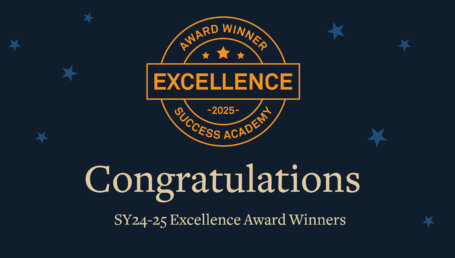
Fact 1: Charter schools are public schools.
Charter schools are publicly created, publicly regulated, and publicly funded. All children eligible for admission to a district school can apply to a charter school.
Fact 2: Charter schools do not select students.
Charter schools have simple enrollment applications that take families less than five minutes to complete. When there are more applicants than seats, students are admitted by a random lottery.
Fact 3: Charter schools have stronger accountability than their district counterparts.
New York charter schools are authorized by the State Education Department or the State University of New York (SUNY). They must have their charters renewed every five years, based on a detailed review of school finances, student achievement, and parent satisfaction. Unlike district schools, charter schools that fail to meet the strict criteria for renewal can be shut down.
Fact 4: Charter schools deliver better student outcomes for children of color.
In 2016, New York City charter schools helped African American and Hispanic students perform far better in math and English than their counterparts at district schools. Children of color at Success Academy also outperformed white students citywide (94% versus 58% in math and 80% versus 59% in ELA).
Fact 5: Charter schools and district schools serve comparable numbers of students with special needs — but charters are far more effective.
Across New York City charter schools, including Success Academy, approximately 16% of students have disabilities — compared with 18% at district schools. On the 2016 state exams, 79% of students with disabilities at Success passed math, compared with 11% of citywide special-needs students; 51% passed English, versus 9% citywide.
Fact 6: Charter schools help English Language Learners rapidly become fluent.
Charter schools are significantly more effective at helping English Language Learners achieve language proficiency than district schools. At Success Academy, most English Language Learners become proficient in English within two years — versus five years or more at district schools. On the 2016 state exams, 90% of Success Academy English Language Learners passed math, compared with 13% of citywide English Language Learners; 60% passed English, versus 4% citywide.
Fact 7: Charter schools offer a longer school day and more robust curriculum, educating the whole child.
Charter schools invest heavily in enrichment opportunities for kids, and many have progressive philosophies. At Inwood Academy of Leadership Charter School, students participate in competitive robot building. At Renaissance Charter High School, agriculture courses are taught using a rooftop greenhouse. Success Academy devotes the majority of the school day to small-group and experiential learning. The curriculum includes chess, art, dance, sports, robotics, debate, field trips, and daily science experiments.
Fact 8: Charter schools keep more of their students over the years than district schools.
Both Success Academy and NYC charters overall retain more of their students each year than district schools. At Success, the annual attrition rate is 10% and has remained stable for years. Research by education journalist Beth Fertig of WNYC found that across all charters, the rate is 11%, compared with 13% for district schools citywide. In the communities of color where many charters are located, district schools lose even more kids — for example, in District 5 (Central Harlem), annual attrition among students in grades K-4 is 24%.
Fact 9: Charter schools receive less public funding than district schools.
Charter schools that aren’t co-located receive $2,914 less for each general education student than traditional public schools do. That’s a funding gap of 16%. Even charter schools that are given access to public space receive slightly less per-pupil funding. Charter schools are particularly underfunded when factoring in their longer school day and school year.
Fact 10: Both charter and district schools receive private funding.
By law, both charter schools and district schools can receive private funding. District schools in wealthy communities often benefit from fundraising efforts by their PTAs. In contrast, charter schools predominantly serve children in underprivileged neighborhoods, where schools and families lack significant financial resources.
Fact 11: Charter schools account for only 10% of co-locations.
Co-location is extremely common in New York City — about two-thirds of all public schools are co-located. Most (90%) co-locations occur between district schools. Only 10% involve a charter school. Before a charter school can move in, the city undertakes an extensive planning process that includes an outline of the impact of the charter school on building facilities.
Fact 12: Charter school co-locations make good use of public space.
Charter schools are co-located only in facilities with a significant amount of available space; these are very common in neighborhoods with failing district schools. According to an NYC Department of Education analysis, there are 67 school buildings with at least 500 empty seats.
Fact 13: Charter schools receive less space overall than district schools.
In buildings where charter schools and district schools are co-located, 52% of the charter schools are operating above capacity — compared with 16% of the district schools. Charter schools typically educate more children per room than district schools. Success Academy, for example, averages 27 to 28 students per section, versus 22 students per section at co-located district schools.











